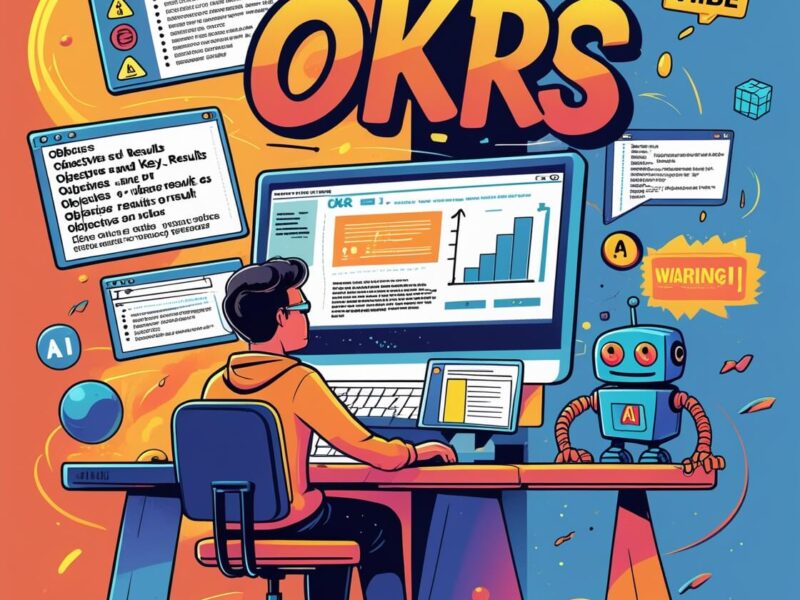The Paradox of Modern Development
In today’s volatile tech landscape, teams face a critical dilemma: Agile development enables rapid adaptation to change but risks becoming a tactical treadmill, while Objectives and Key Results (OKRs) provide strategic direction but can feel disconnected from daily work.
The most innovative organizations—Google, Spotify, and Microsoft—have cracked this code by integrating both systems into a cohesive operational engine. As a UX designer and solutions architect who’s implemented this fusion across Fortune 500 companies, I’ve witnessed how this synergy transforms output into outcomes.
I. The Frameworks Decoded: Why They Belong Together
A. Agile’s Execution Power
Born from the 2001 Agile Manifesto, Agile development replaces rigid waterfall planning with iterative cycles (Sprints) that:
Embrace changing requirements through regular retrospectives
Deliver working software in 2-4 week increments via Scrum/Kanban
Prioritize customer collaboration over contract negotiation
Yet Agile alone has a blind spot: Teams often optimize for velocity (story points completed) rather than impact (business value delivered). I’ve seen countless “Agile” teams ship features on schedule that failed to move revenue or user engagement metrics.
B. OKRs’ Strategic Compass
Popularized by John Doerr at Google, OKRs align organizations through:
Objectives: Qualitative, inspirational goals (e.g., “Dominate mobile search UX”)
Key Results: 2-5 measurable outcomes per objective (e.g., “Achieve 95% mobile search satisfaction by Q4”)
Unlike top-down KPIs, OKRs cascade bidirectionally—leadership sets company objectives, while teams propose how they’ll contribute. Intel’s 70% achievement rule encourages ambitious “moonshots” without penalizing “falling short”.
C. The Synergy Effect
When combined, these systems form a closed-loop strategy-execution engine:

II. Integration Blueprint: 4 Models for Technical Teams
Model 1: Agile OKRs (Scrum Master-Driven)
Embed OKRs directly into sprint rituals:
Sprint Planning: Map backlog items to Key Results (e.g., “Redesign checkout flow” → KR: “Reduce steps from 5 to 2”)
Daily Standups: Report blockers to KR progress vs. task completion
Retrospectives: Analyze confidence scores in OKR tracking tools
Tool Stack: Jira OKR plugins (Synergita), ClickUp Goals
Model 2: OKR-Infused Sprints (Dual Cadence)
Divide sprints into two phases:
Outcome Phase (Week 1-2): Work on KR-critical tasks
Feedback Phase (Week 3-4): Address stakeholder inputs and adapt
UX Benefit: Ensures user research directly informs KR prioritization.
Model 3: Operational Alignment (SAFe Scale)
For enterprises, use OKRs as Strategic Themes in SAFe:
Portfolio OKR → Program KR → Team Sprint Goal
IBM’s transformation OKR:
Objective: Implement agile methodologies globally
Key Results:
Train 90% of employees by Q2
Increase delivery speed 30% by Q3
Reduce time-to-market 25% by Q4
Model 4: Role Mapping
| Agile Role | OKR Role | Integration Duty | |
|---|---|---|---|
| Product Owner | OKR Champion | Links backlog to KRs | |
| Scrum Master | OKR Product Owner | Facilitates OKR check-ins | |
| Dev Team | KR Owners | Self-organize around outcome tasks |
III. Why This Fusion Drives Digital Transformation
A. Fixing Agile’s Strategic Gap
Agile teams often prioritize backlog items without context. OKRs provide the “why”:
*A Spotify squad reduced “notification volume” KR by 60% after linking it to the objective “Respect users’ attention.” Without this, they’d have optimized for click-through rates alone.*
B. Preventing OKR Theater
OKRs fail when they’re PowerPoint decorations. Agile rituals ground them in reality:
Weekly Confidence Checks: Rate KR progress (0.0–1.0) in standups
Burndown Charts: Overlay KR progress vs. sprint completion
Architect Tip: Use Grafana dashboards to visualize KR metrics alongside deployment frequency.
C. Accelerating Autonomy
OKRs act as “guardrails” for self-organizing teams. At Microsoft, engineers proposed KRs for “Improve Azure latency,” then designed solutions without micromanagement.
IV. Implementation Toolkit: Frameworks & Tactics
A. OKR Crafting Rules for Tech Teams
Objective Formula: Verb + Impact + User (e.g., “Revolutionize checkout for mobile shoppers”)
KR Standards:
Must influence Lag Measures (e.g., revenue) via Lead Measures (e.g., session duration)
Use ratios, not absolutes (“Reduce support tickets/MAU by 20%”)
SaaS Example: “Increase free→paid conversion” → KR: “Achieve 12% signup-to-trial rate”
B. Cadence Alignment
| Cadence | OKR Activity | Agile Ceremony | |
|---|---|---|---|
| Quarterly | OKR Planning/Review | PI Planning (SAFe) | |
| Monthly | KR Mid-Review | Sprint 4 Retrospective | |
| Bi-Weekly | Confidence Check-ins | Sprint Review | |
| Daily | KR Blockers Discussion | Standup (first 3 minutes) |
C. Tool Stack Recommendations
Startups: Mooncamp (free tier) + GitHub Projects
Scale-Ups: Quantive (AI-powered OKRs) + Jira
Enterprises: IBM Targetprocess (SAFe integration) + Tableau
UX Pro Tip: Embed OKR progress bars into internal dashboards using React/VS Code plugins.
V. Real-World Case: Fintech Transformation
Challenge: A bank’s mobile app team delivered sprints on time but saw flat user growth.
Solution:
Set Q1 OKR:
Objective: Become users’ primary banking channel
KR1: Increase WAU/MAU ratio to 65%
KR2: Achieve 4.5-star app store rating
KR3: Reduce balance-check steps to 1 click
Sprint Alignment:
Prioritized “one-tap balance” feature over “new mortgage calculator”
Added KR confidence to retros
Result: WAU/MAU hit 68% in 5 months via 3 sprint cycles.
VI. Anti-Patterns to Avoid
The Agile-OKR Misalignment Trap
| Anti-Pattern | Consequence | Fix | |
|---|---|---|---|
| KR = Sprint Completion | Features ship; outcomes lag | Tie KRs to user behavior metrics | |
| Quarterly OKRs, Daily Agility | Teams ignore strategic goals | Bi-weekly KR-confidence checks | |
| OKRs as Performance Reviews | Sandbagging goals | Decouple OKRs from bonuses |
Architect Insight: I once audited a team whose “Improve scalability” KR had no latency metrics. They’d optimized databases without measuring user impact—a classic output-over-outcome failure.
VII. The Future: AI-Enhanced OKR-Agile Cycles
Emerging tools like Quantive’s Strategy AI are revolutionizing integration by:
Predicting KR Confidence: Using historical sprint data
Auto-Prioritizing Backlogs: Based on OKR impact scores
Generating Retro Insights: Linking blocker patterns to KR risks
Conclusion: Building Your Navigation System
Agile is the engine that propels your product forward; OKRs are the GPS ensuring you’re heading toward value. By embedding objectives into sprint rhythms, teams shift from “Did we ship?” to “Did it matter?” As John Doerr reminds us: “Measures matter more when they’re counterintuitive.” Start your integration with one pilot team—measure their KR impact versus control groups. In 2025’s AI-driven chaos, this fusion isn’t just optimal; it’s existential.
Continue your journey:


